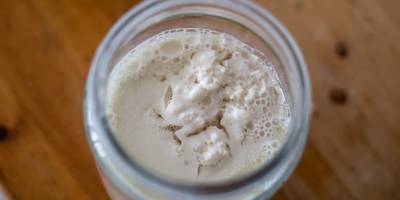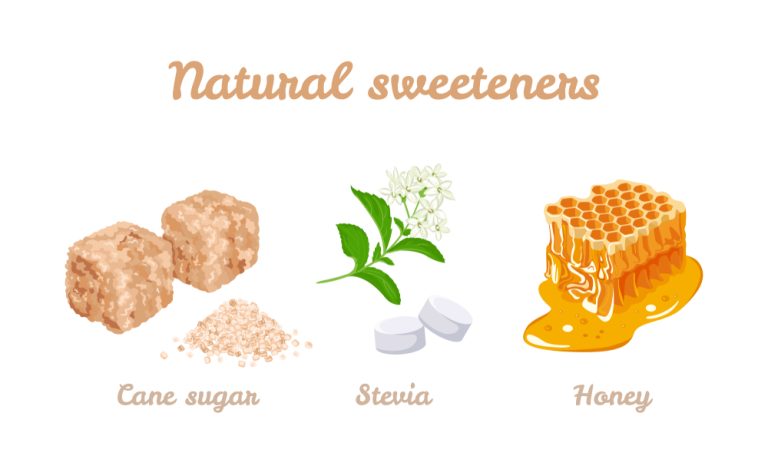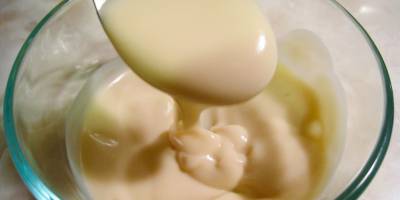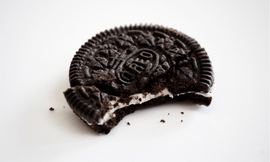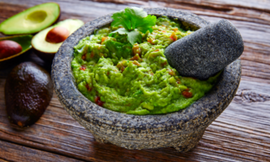Before I went vegan I used to drink milk kefir from time to time and I really liked it.
For the ones of you, who never heard about it, Kefir is a fermented drink, that is based on cow, goat or sheep milk.
It is the only milk drink, that is made with a kind of yeast and it originates in the Caucasus mountains.
One hundred years ago it became quite popular, since a scientist liked the old age of people in the Caucasus mountains to their daily intake of fermented milk.
The taste of kefir resembles yogurt, even though it is a little bit sparkly and sometimes tastes alcoholic.
Especially homemade vegan kefir, usually contains small amounts of alcohol.
Probiotics Against Candida
I decided to drink kefir, since a doctor diagnosed me with candida, a condition that is usually connected to problems in the digestive system.
I asked my friend, who is an osteopath, if there are any natural ways to solve the problem.
She suggested probiotics, that can be normally found in miso and in other fermented foods and drinks.
Probiotics in a Vegan Diet
I started with miso, but after one week I had enough.
My kombucha experiments didn’t work out that well and Korean kimchi on a daily basis is just too much for me.
I also tried to make vegan yogurt, which is a little complicated, if you use another vegan yogurt as a starter culture (you need living yogurt cultures as a starter).
The soy-milk did not really transform and the milk went bad instead.
Making vegan yogurt with a spoon on non-vegan yogurt works quite well, but I want to avoid using any dairy (even though I would only need it for the first yogurt).
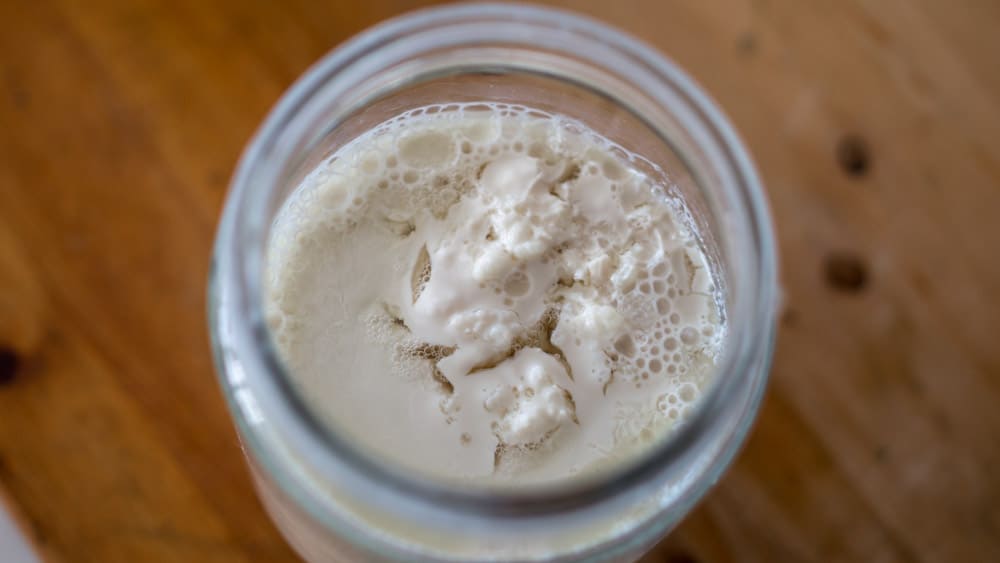
Where to Get a Kefir Culture
So i thought, vegan kefir might be the way to go.
I tried a health shop first and they told me, that it’s forbidden to sell “living” cultures like kefir.
I searched on the internet and I found someone, who was selling kefir cultures for five bucks just close to the place, where I work.(Click here to check on Amazon).
We met on the same day and he gave me a jar with skimmed milk and a kefir culture inside.
How to Prepare Vegan Kefir
At home I opened the jar and cleaned the culture with water
It had the size of a walnut and looked like cauliflower.
I sterilized a jar with boiling water and poured half a liter of soy-milk (cheap kind with added sugar) inside.
Since kefir produces a lot of gas, the jar should stay open.
I decided, that a plastic bag with some small holes would be a good cover, since it protects the kefir from flies or other insects.
The instructions on the internet suggested to stir the kefir after a couple of hours (for an extra creamy result).
I did so and used Chinese chopsticks, since kefir should not touch any metal.
I waited 24 hours and tried my vegan kefir.
The result was super delicious! Slightly sour, refreshing and really authentic!
Oat-Milk Versus Soy-Milk
I repeated the process two more times (24 hours are more than enough) and always sterilized my glass.
After the second time, another little kefir culture appeared (the culture grows permanently) .
I put it in a separate jar and repeated the same process with oat milk.
The result was even tastier (very smooth and creamy).
Since I need to pay attention to my protein intake, I am going to stick with soy-milk or a soy-milk/oat-milk mix though…
Attention: Always check, if there are still some small kefir cultures in your jar!
I forgot a raisin sized culture and took the jar with me during a road-trip.
The jar almost exploded and the kefir tasted more like beer than like yogurt (since it kept fermenting)!
Some people suggest to use coconut milk.
I am sure, that it works as well, but the result contains around 17 percent of fat (if you use it straight from the can).
I would use coconut kefir most likely to make creamy sauces or frostings for my homemade cakes.
As a drink, its too heavy for me though.
What To Do With Vegan Kefir
I consume my plant based kefir in the morning after waking up, even before I have coffee or tea.
I have the impression, that it prepares my stomach for other food or drinks.
If I enjoy it in the afternoon, I mix it with oats, fruits, dates and nuts.
The vegan kefir makes an amazing substitute for buttermilk! Try cakes, pancakes or even vegan ice-cream with your homemade kefir!
Did I feel any changes?
I like the taste of plant based kefir and I feel very good.
It helps my digestion and since I started drinking it, candida did not return.
I am going to wait a couple of months though and check, if I feel any long-term effects.
Even if not, vegan kefir is an inexpensive alternative to vegan yogurt and makes my oatmeal and my cakes even more delicious!
How Many Calories Does Water Kefir Contain?
That depends on how long it ferments.
As time passes Kefir Grains consume more sugar.
Generally, the more sour the Water Kefir the fewer calories it contains.
If Coconut Water is used the resulting Coconut Water Kefir would contain the least amount of calories as the Coconut Water has less natural sugar to begin with.
How Does Kefir Compare to Yogurt?
The available yogurt is much less effective than Kefir.
Yogurts may be pasteurized killing all beneficial microbes.
Some products contain synthetic stabilizers which make them more difficult to digest.
And most commercial products have less potent probiotics.
Specially, the bacteria and yeast found in commercial yogurt are transient meaning they will not colonize your digestive tract.
Kefir contains several major strains of beneficial bacteria not commonly found in yogurt .
Kefir also contains beneficial yeasts, such as Saccharomyces kefir, which can dominate, control and eliminate destructive pathogenic yeasts in the body.
They do so by protecting the mucosal lining where unhealthy yeast and bacteria reside, forming an army that cleans up and strengthens your intestines.
The body becomes more efficient in resisting such pathogens as E. coli and intestinal parasites.
How Kefir Grows?
The grains are created when certain types of bacteria build crystal structures made of sugar to live within.
Over time, other types of bacteria and yeast find their way into the crystal structure.
If they are beneficial to the existing crystal, they are allowed to stay.
The mixture of microbes help defend each other and act in symbiosis to maintain a stable culture.
The group of co-operative bacteria live together and multiply together.
They are able to defend themselves better as a group than any single strain of bacteria could on its own.
Water Kefir Grains use sugar in a process called fermentation.
Sugar is the fuel that the bacteria and yeast in the grains use to make energy.
The liquid that cultures grow in is called the growth medium.
When there is not enough sugar available in the growth medium for the grains to keep fermenting, they will stop producing energy.
Without this energy, the grains will stop reproducing and will eventually die.
These grains contain many types of microbes. Some of these microbes can create, extend, or fix the structure they live in.
Others can defend the structure against “enemy” bacteria. As the grain takes in sugar, microbes inside use the energy to reproduce thus crowding the structure.
To address the crowding, the bacteria capable of maintaining the sugar crystal have to make more compartments for all the microbes to live in.
As the crystal grows bigger and more complex, it becomes visible to the naked eye. This is what we recognize as a grain.
As the grain grows larger, part of it will break away and start functioning as a separate grain.
When a grain breaks bacteria good at rebuilding the sugar crystal repair the section where it broke away and the two grains heal becoming two completely separate grains.
Each grain continues to use sugar, grow, break away and heal producing more grains.
This cycle continues as long as fuel is available. This is life!
What is The Alcohol Content in Water Kefir?
As with all cultured and fermented foods, a small amount of naturally occurring alcohol is present in the finished product.
Scientific studies show Water Kefir to contain between 0.038% – 2% alcohol, or 16-38 g/L (grams per liter).
With the normal amount being around .08% or less.
Shorter fermentation will allow less alcohol production.
How to Freeze Water Kefir Grains?
Tibi can also be drained and frozen in a sealed freezer bag or container, and will survive up to six months in the freezer.
When ready to reuse, take out of the freezer and put straight into sugar water made up as normal.
Don’t use heat, the microwave, or direct sunlight to defrost them first, they will defrost more gently in the water.
Drain after 48 hours and place in new sugar water.
This first batch may need to be discarded as it won’t have kefired properly and will contain all the dead organisms killed by the freezing process.
As with dehydrated crystals, it may take a few batches for the tibi to reactivate and make kefir normally, and a couple of weeks for it to get it’s full exuberance and fizz back.
Give tibi that’s been dehydrated or frozen at least a month of growing normally in regular changes of sugar water before trying to freeze or dehydrate it again.
Doing this too often will both weaken the tibi and change the balance of micro-organisms in the grains.
How to Dehydrate Water Kefir Grains?
To dehydrate water kefir grains, drain the water off the tibi and spread them out on a clean cloth or piece of mesh, and cover to keep insects and dust off them.
If you have a dehydrator with a thermostat, it’s fine to use but on a barely warm setting, I keep mine to less than 35 degrees C.
Don’t use the oven, microwave, or direct sunlight to dry the tibi, this will kill them!
If you don’t have a dehydrator, you can spread them out on non-stick baking paper and let them air dry.
When fully dry, they will have shrunk significantly, feel hard and dry to the touch, and look like demerara sugar crystals.
Put them in a clean dry jar in the fridge or anywhere cool and dry, and they should be good for six months.
Is There Anyone Who Shouldn’t Use Water Kefir?
As with any new food, even if you are normally well, it’s best to introduce water kefir gradually, starting with half a cup a day and increasing as tolerated.
Most people have no problem with water kefir, but some people may find it has a “cleansing” effect on the gut causing loose stools.
Because a small amount of fructose is present in the finished water kefir, people with diabetes may wish to monitor their blood sugar levels more closely when introducing kefir.
Ensure the kefir is fermented for at least 48 hours so that all the glucose is used up.
Anyone with known fructose malabsorbtion should avoid drinking water kefir that has been fermented for less than 48 hours.
Ideally ferment for 72 hours, and start with small amounts to observe if any symptoms develop.
Many people with candida (thrush or yeast) problems find water kefir beneficial, as it contains friendly strains of candida which replace the symptom causing varieties, however the small percentage of people who are extremely sensitive to any candida may find their symptoms worsen.
Also, a touch indelicately here, anyone with a big flatulence (wind) problem needs to go slow starting water kefir, and avoid doing fizzy secondary ferments with fruit juices, which do produce a lot of extra carbon dioxide gas.
Gas in equals gas out! See tips for making water kefir less fizzy below.
For the majority of people, water kefir is well tolerated and offers significant health benefits, as well as tasting good!
Recents Posts:

